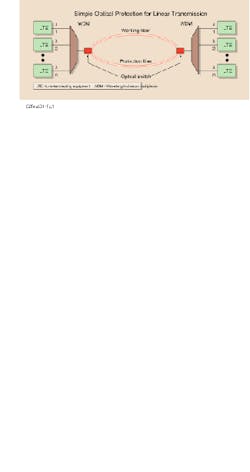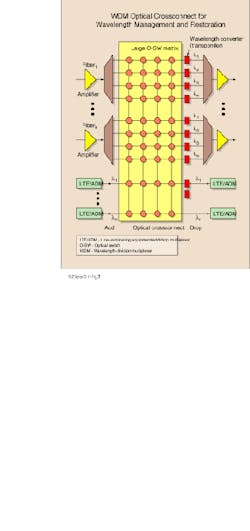Optical crossconnects: toward a photonic network
Optical crossconnects: toward a photonic network
While some issues remain unresolved, optical crossconnects could see deployment as early as 1999.
STEVE CARTER and NAOKI CHINONE, Hitachi Telecom (usa) Inc.
About 30 years ago in the movie "The Graduate," Dustin Hoffman`s character was given the following one-word career advice: "Plastics." Today, a sequel might use updated advice: "Photonics." The explosive growth of the Internet and data communications is a hot topic in the mass media and is driving unprecedented technological progress in the communications industry.
Photonics, as manifested in the evolution to the all-optical network, is hailed as the next wave in communications technology. In its purest form, the all-optical network can be defined as a network in which all switching, routing, transmission, and restoration functions reside entirely in the optical domain. Today, only transmission has reached this goal; the next steps are restoration and routing. Optical crossconnects will soon be ubiquitous. They offer advantages in management and overall cost control by
maximizing use of existing fiber infra-
structure through engineered restoration schemes and efficient routing,
reducing cost and increasing network
reliability through elimination of optical/electrical conversion steps and equipment,
provisioning and grooming more effi-
ciently,
managing individual wavelengths and
channels.
Prevalent time-division multiplexed Synchronous Optical Network (sonet) transmission rates are increasing from 2.5 Gbits/sec (OC-48) to 10 Gbits/sec (OC-192) and beyond, and wavelength-division multiplexing (wdm) systems will soon deliver 32, 40, or more channels. Managing this complexity is a key to realizing the full potential of the optical network. Because optical crossconnects are transparent to the time-division multiplexed bit rate, OC-12, OC-48, and OC-192 routes can share the same fibers in the survivable fiber network.
Architecture and applications
Optical networks can be visualized as two basic layers: The optical multiplex section (oms) layer provides the networking of multiwavelength optical signals. Analogous to today`s interoffice trunking network, routing and restoration of the physical fiber are supported by the oms layer. The optical channel (och) layer provides end-to-end networking of individual optical wavelength channels. The och layer supports the optical services delivered to the end-user.
Restoration and wavelength management are the first applications chosen for optical crossconnect deployment. These applications present significantly different requirements for design and configuration of equipment.
The building block for optical crossconnects is the optical switch element. Optical switches at the oms layer switch multiple wavelengths traveling in a single fiber to one of several alternative fibers. Switching in this layer alters the route of all optical signals on the same fiber. The optical switch technology required for oms layer switching is now available in several forms (see table on page 98).
In contrast, optical switches at the och layer handle individual wavelengths that have been separated by a wavelength demultiplexer. After routing, wavelengths are multiplexed for continuation to their termination points. Figures 1, 2, and 3 illustrate three applications for optical switching and optical crossconnect technologies, from simple optical protection for point-to-point applications to mesh and ring networks at the oms layer and wavelength management at the och layer.
Major applications
Bulk route restoration will be the first application for optical crossconnects. Trials are now under way, such as mci`s trial in its Dallas, TX-area network using Hitachi`s optical crossconnect equipment. Bulk route restoration is an application of oms layer optical switching that allows an optical signal to be protected automatically by diverse fibers, without the need for sonet restoration. Mesh networks are especially well-suited for restoration by optical crossconnects because there are multiple alternative paths available, and there is a significant opportunity to engineer protection schemes to maximize overall fiber use. Optical crossconnects will also find applications in ring networks and ring interconnection, which enable carriers to use simple terminal equipment designed for linear transmissions in the ring networks.
Wavelength management represents a second application. The multiple wavelengths created by wdm systems offer both a challenge and an opportunity. The challenge is that carriers now must manage up to 40 wavelengths per fiber. The opportunity is that carriers can use these wavelengths not only to carry their own traffic, but they can also sell or lease them to other service providers who resell the capacity to end-users. An ideal wavelength-routing optical crossconnect would include
wavelength level switching,
wavelength conversion,
wavelength multiplexing and demulti-
plexing,
wavelength signal monitoring.
Although expensive, wavelength routing can be accomplished today with a combination of oms layer switching, wavelength transponders, and wdm. Multiwavelength optical signals can be demultiplexed into individual wavelengths with wdm, switched individually via och layer optical crossconnects, then converted to other wavelengths with transponders. A few vendors are exploring this technique for early applications of wavelength routing.
Provisioning and grooming represents a third major application. Network reconfiguration for new service setup, changes in traffic patterns, and increases in traffic volume can be handled within the optical layer by och layer optical crossconnects through the associated network element management systems.
Technical issues
As with any new technology, a number of technical issues must be addressed before optical crossconnects are universally deployed.
Optical switch devices. As shown in the table, at least five technologies are being used or studied for optical switch implementation. Each has its own set of advantages and disadvantages. Much of the lab work in progress is aimed at improving the performance of the switch devices, shrinking and integrating them into the package, and increasing the size of the switch matrix. The fiber-based optomechanical switch device, with its small loss, excellent wavelength transparency, low power consumption, and fast switching times, is well-suited to restoration applications. For larger switch matrix configurations, the polymer-based switch and the semiconductor optical amplifier switches are promising because of their potential for miniaturization. Although further improvement is necessary, these switches are also better suited for wavelength routing applications.
Element management systems. Sophisticated element management systems to control such parameters as restoration schemes, routing parameters, provisioning, and grooming will prove critical to the success of optical crossconnects. Since the element management systems will handle data from many different sources and involve equipment from many different vendors, standards-based operation and a user-friendly graphical interface will be essential. Defining the optical supervisory channel and the information model are two of the issues topping the agendas of the standards organizations.
Wavelength conversion. This "anything to anywhere" application offers maximum flexibility. For example, if a route is transmitting at 1533 nm and a fiber failure occurs, wavelength conversion along the restoration route allows the transmission to shift to an available 1557-nm route segment for restoration, then ultimately revert to its original wavelength. Although current transponders can be used as wavelength converters, bit-rate transparency and the elimination of the optical/electrical conversion step will ultimately be required.
Current activity
Research, development, evaluation, and testing activities are in progress at manufacturers, service providers, universities, and other organizations around the world. In the United States, the following are examples of that activity:
The Multiwavelength Optical Networking (monet) Consortium focuses on demonstrating the technical and economic feasibility of multiwavelength optical networking. Members of the consortium are at&t, Bell Communications Research, Bell Atlantic, BellSouth, Lucent Technologies, Pacific Telesis, and Southwestern Bell tri (see Lightwave, April 1997, page 1).
mci-Hitachi: In August 1997, mci and Hitachi announced a trial of Hitachi`s optical crossconnect systems in mci`s Dallas-area network (see Lightwave, October 1997, page 1). Handling sonet traffic at OC-48 and OC-192 rates, the trial demonstrated the feasibility of a restoration application in an existing fiber-optic network.
Lucent Technologies: In May 1997, Lucent announced the industry`s first all-optical crossconnect (see Lightwave, July 1997, page 1).
Are we there yet?
When will the all-optical network arrive? When will optical crossconnects be widely deployed? Actually, a true top-to-bottom optical network is many years away, especially on the access side, as copper will continue to be adequate for traditional telephone voice service, and other copper-based technologies, such as digital subscriber line and cable modems, will meet the access needs of many residential and small business subscribers. But in long-haul transport and in metropolitan applications where there are large concentrations of corporate users, optical technologies will be implemented much earlier. Expect to see commercial deployments of optical crossconnects in 1999 or 2000. u
Steve Carter is senior manager of transmission systems marketing, Hitachi Telecom (usa) Inc., Norcross, GA. Naoki Chinone is general manager at the Dallas Advanced System Center, Hitachi Telecom (usa) Inc., Richardson, TX.Fig. 3. With the addition of wavelength converters, optical crossconnects can also provide wavelength management and restoration in a wdm application using the och layer.



